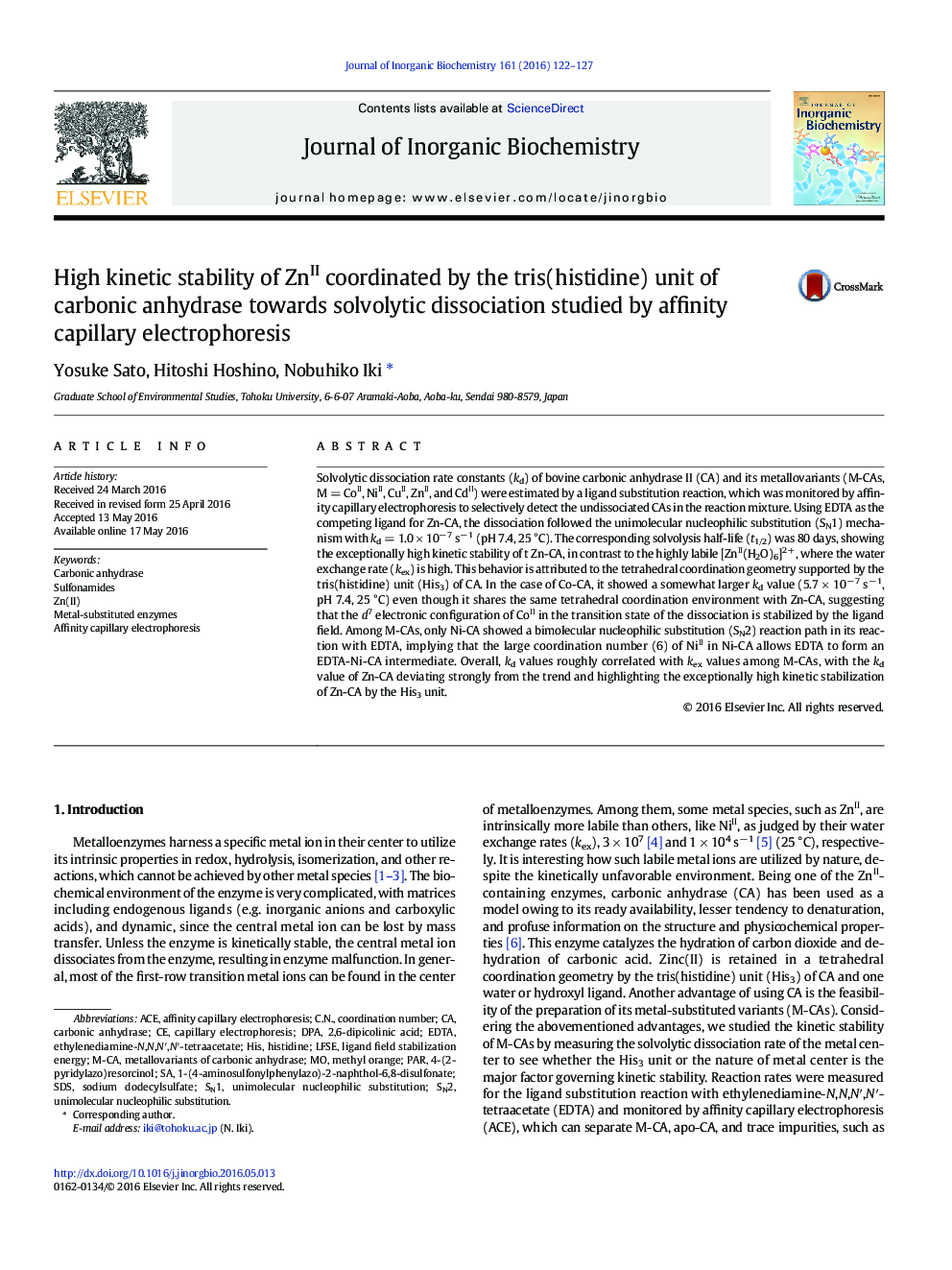| کد مقاله | کد نشریه | سال انتشار | مقاله انگلیسی | نسخه تمام متن |
|---|---|---|---|---|
| 1315811 | 1499426 | 2016 | 6 صفحه PDF | دانلود رایگان |

• Dissociation rates (kd) of metal ions from carbonic anhydrase (CA) were estimated.
• The kd of metallovariants (M-CAs, M = Co, Ni, Cu, Cd, Zn) was smallest for Zn-CA.
• The His3 motif of CA strongly retains the kinetically labile ZnII.
• In the reaction with EDTA, only Ni-CA reacted via both SN1 and SN2 paths.
• Other M-CAs reacted exclusively via the SN1 path.
Solvolytic dissociation rate constants (kd) of bovine carbonic anhydrase II (CA) and its metallovariants (M-CAs, M = CoII, NiII, CuII, ZnII, and CdII) were estimated by a ligand substitution reaction, which was monitored by affinity capillary electrophoresis to selectively detect the undissociated CAs in the reaction mixture. Using EDTA as the competing ligand for Zn-CA, the dissociation followed the unimolecular nucleophilic substitution (SN1) mechanism with kd = 1.0 × 10− 7 s− 1 (pH 7.4, 25 °C). The corresponding solvolysis half-life (t1/2) was 80 days, showing the exceptionally high kinetic stability of t Zn-CA, in contrast to the highly labile [ZnII(H2O)6]2 +, where the water exchange rate (kex) is high. This behavior is attributed to the tetrahedral coordination geometry supported by the tris(histidine) unit (His3) of CA. In the case of Co-CA, it showed a somewhat larger kd value (5.7 × 10− 7 s− 1, pH 7.4, 25 °C) even though it shares the same tetrahedral coordination environment with Zn-CA, suggesting that the d7 electronic configuration of CoII in the transition state of the dissociation is stabilized by the ligand field. Among M-CAs, only Ni-CA showed a bimolecular nucleophilic substitution (SN2) reaction path in its reaction with EDTA, implying that the large coordination number (6) of NiII in Ni-CA allows EDTA to form an EDTA-Ni-CA intermediate. Overall, kd values roughly correlated with kex values among M-CAs, with the kd value of Zn-CA deviating strongly from the trend and highlighting the exceptionally high kinetic stabilization of Zn-CA by the His3 unit.
Solvolytic dissociation rates (kd) of carbonic anhydrase II (CA) and its metallovariants (Co, Ni, Cu, Cd) were determined. Native CA showed the smallest kd value (1.0 × 10− 7 s− 1 at pH 7.4, 25 °C), suggesting that the tris(histidine) unit is an effective motif to retain the kinetically labile ZnII.Figure optionsDownload as PowerPoint slide
Journal: Journal of Inorganic Biochemistry - Volume 161, August 2016, Pages 122–127